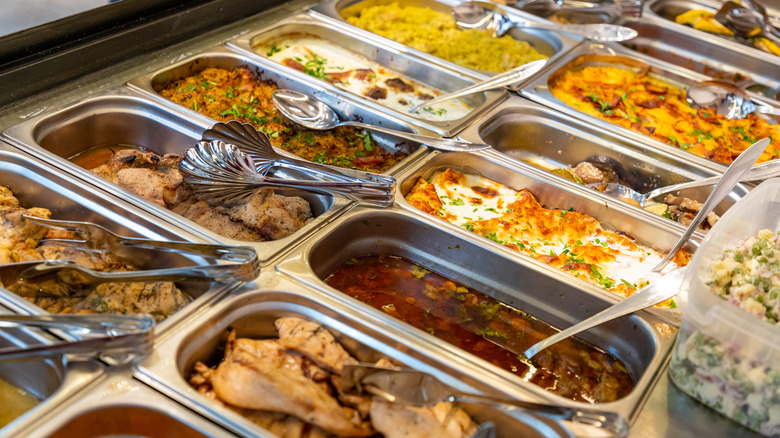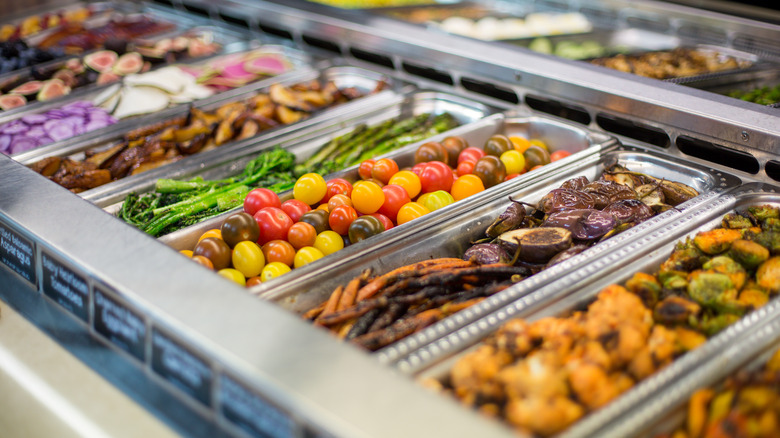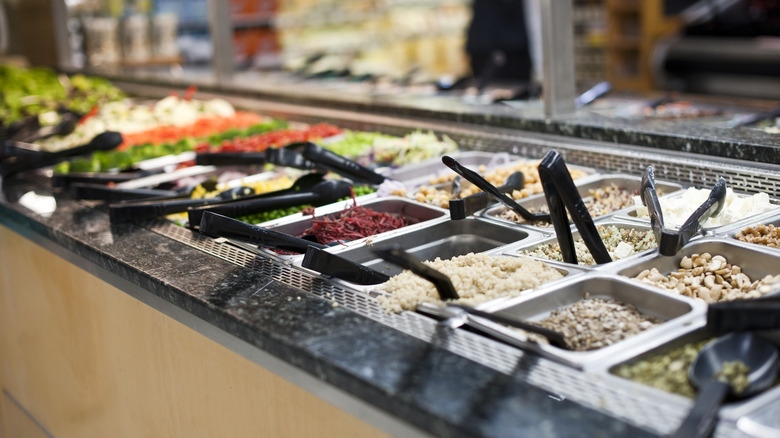The Food Safety Mistake We All Make At Grocery Store Hot Food Bars
It's easy to underestimate the humble appeal of a hot food bar – unless you grew up going to a grocery store that didn't have one. For those who didn't see one of these buffets until later in life, it's hard to forget the first time you saw the golden glow of heat lamps and smelled the comforting aroma of fresh, ready-to-eat food. The hot food bar is a great grocery store hack – a lifesaver for any hungry individual trying to save time, money, or both. Even hot food items at more expensive grocery stores can be reasonably priced, and given the variety of options available, they are a great alternative to only eating fast food when you need a quick bite. However, when it comes to food safety, hot food bars pose the same risk as any dish that's left out in the open: If the temperature isn't right, it can mean disaster for your insides. That's why it's essential that you check the temperature at the grocery store's hot food bar before grabbing any food.
From industrial freezers to your kitchen refrigerator, setting appliances to the correct refrigeration temperature is incredibly important. Any hot food bar worth its salt should have a thermometer proudly displayed to assure customers everything is safe to eat. According to the USDA, hot food should be kept at a minimum of 140 degrees Fahrenheit. Anything lower and the food may become a breeding ground for bacteria.
Stay out of the temperature danger zone
Bacteria can be surprisingly finicky, and will only grow if the environmental conditions are right. Unfortunately for us humans, part of those conditions in which bacteria could grow include temperatures between 40 and 140 degrees Fahrenheit. The USDA dubs this temperature range the "Danger Zone" for bacterial growth, and warns that "[hot] food should not be left out more than one hour." Otherwise, you may contract food poisoning and all the unpleasantness that comes with it. This goes for homemade food too, so after you've had your fill of a delicious homemade meal, don't wait too long to store the leftovers in the fridge.
Even if a hot food bar's thermometer says that everything is hot enough, there may be other factors that cause the temperature to fluctuate. Heaping trays of food, as exciting as they may sound, are actually something you may want to avoid when picking out your lunch. When there's too much food in a container, it's harder for everything to properly heat up, increasing the chance of you choosing something that isn't safe to eat. To avoid this, opt for hot bars where the food doesn't overflow from the pans, and look out for steam and other signs that everything is hot enough. Just don't go around sticking your hands into the food to test it!
The rule for cool food
Oftentimes, hot food bars will be accompanied by stations to buy cold food as well. Even grocery stores that lack a hot food area usually have some sort of deli or refrigerator section that offers sandwiches, salads, and the like. These cold selections should be kept at 40 degrees Fahrenheit or lower. And while "there's no benefit to warm food being held hotter than 135 degrees," as professor of environmental health and former public health deputy Gevork Kazanchyan MS, REHS, CP-FS explained to Martha Stewart, "the colder the better for cold items." Furthermore, the USDA asserts that even cold food shouldn't stay away from refrigeration for more than two hours.
Just as the hot food bar can be a haven for those with less than 30 minutes to spare for lunch, it also serves as a bit of a treat after an intensive grocery run. Once you've made your list, trekked from the dairy aisle and back, and piled everything in your cart, a warm meal is just the thing to fuel you the rest of the way back home. So, make the most of the opportunity by ensuring you won't regret stopping at the smorgasbord.


